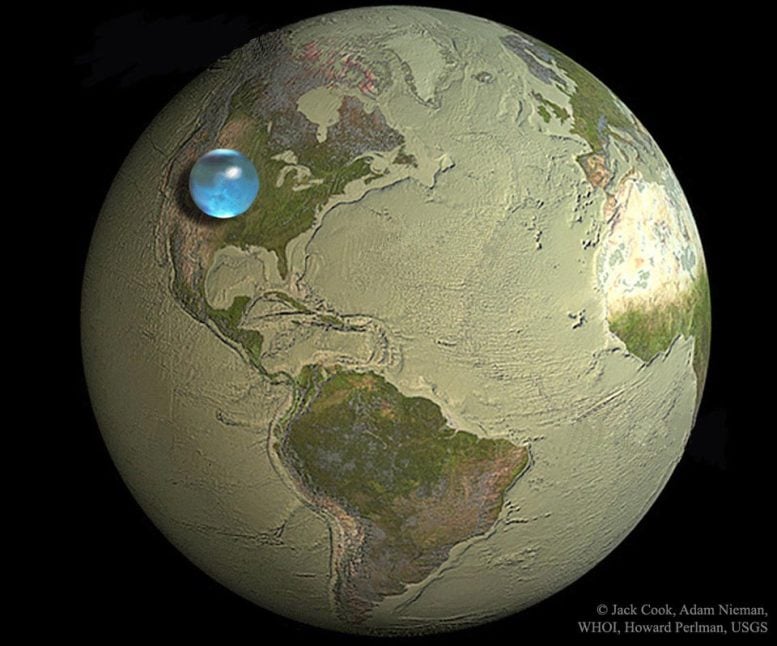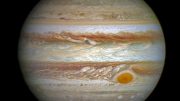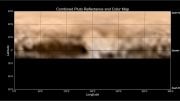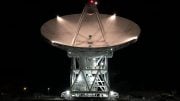
Picture of Earth showing if all Earth’s water (liquid, ice, freshwater, saline) was put into a sphere it would be about 860 miles (about 1,385 kilometers) in diameter. The diameter would be about the distance from Salt Lake City, Utah to Topeka, Kansas, USA. Credit: Illustration by Jack Cook, Woods Hole Oceanographic Institution; USGS
You’ve probably heard the saying that Earth is mostly water, roughly 70%. Well, it turns out that many people have misunderstood the facts and that it’s only the Earth’s surface that is mainly water. To get a better understanding of the limited amount of water on Earth, the USGS gives a visual explanation with one simple picture showing a water bubble comprised of all of Earth’s water.
As you know, the Earth is a watery place. But just how much water exists on, in, and above our planet? The picture above shows the size of a sphere that would contain all of Earth’s water in comparison to the size of the Earth. You’re probably thinking I missed a decimal point when running my calculator since surely all the water on, in, and above the Earth would fill a ball a lot larger than that “tiny” blue sphere sitting on the United States, reaching from about Salt Lake City, Utah to Topeka, Kansas. But, no, this diagram is indeed correct.
About 70 percent of the Earth’s surface is water-covered, and the oceans hold about 96.5 percent of all Earth’s water. But water also exists in the air as water vapor, in rivers and lakes, in icecaps and glaciers, in the ground as soil moisture and earth aquifer, and even in you and your dog. Still, all that water would fit into that “tiny” ball. The ball is actually much larger than it looks on your computer monitor or printed page because we’re talking about volume, a 3-dimensional shape, but trying to show it on a flat, 2-dimensional screen or piece of paper. That tiny water bubble has a diameter of about 860 miles, meaning the height (towards your vision) would be 860 miles high, too! That is a lot of water.
But, as far as people are concerned, almost all of Earth’s water is not usable in everyday life. Water on, in, and above the Earth is never sitting still, and thanks to the water cycle our planet’s water supply is constantly moving from one place to another and from one form to another. Things would get pretty stale without the water cycle!
The vast majority of water on the Earth’s surface, over 96 percent, is saline water in the oceans. But it is the freshwater resources, such as the water in streams, rivers, lakes, and groundwater that provide people (and all life) with most of the water they need every day to live. Water sitting on the surface of the Earth is easy to visualize, and your view of the water cycle might be that rainfall fills up the rivers and lakes. But, the unseen water below our feet is critically important to life, also. How would you account for the flow in rivers after weeks without rain? In fact, how would you account for the water flowing down this driveway on a day when it didn’t rain? The answer is that there is more to our water supply than just surface water, there is also plenty of water beneath our feet.
Even though you may only notice water on the Earth’s surface, there is much more freshwater stored in the ground than there is in liquid form on the surface. In fact, some of the water you see flowing in rivers comes from seepage of groundwater into river beds. Water from precipitation continually seeps into the ground to recharge the aquifers, while at the same time water from underground aquifers continually recharges rivers through seepage.
Humans are happy this happens because people make use of both kinds of water. In the United States in 2000, we used about 323 billion gallons (1.2 billion cubic meters) per day of surface water and about 84.5 billion gallons (0.32 billion cubic meters) per day of groundwater. Although surface water is used more to supply drinking water and to irrigate crops, groundwater is vital in that it not only helps to keep rivers and lakes full, it also provides water for people in places where visible water is scarce, such as in the desert towns of the western United States. Without groundwater, people would be sand-surfing in Palm Springs, California, instead of playing golf.
Just how much water is there on (and in) the Earth? Here are some numbers you can think about:
- If all of Earth’s water (oceans, icecaps and glaciers, lakes, rivers, groundwater, and water in the atmosphere were put into a sphere, then the diameter of that water ball would be about 860 miles (about 1,385 kilometers) across, a bit more than the distance between Salt Lake City, Utah to Topeka, Kansas. The volume of all water would be about 332.5 million cubic miles (mi3), or 1,386 million cubic kilometers (km3). The picture at the top of this page illustrates this.
- A cubic mile of water equals more than 1.1 trillion gallons. A cubic kilometer of water equals about 264 billion gallons.
- About 3,100 mi3 (12,900 km3) of water, mostly in the form of water vapor, is in the atmosphere at any one time. If it all fell as precipitation at once, the Earth would be covered with only about 1 inch of water.
- The 48 contiguous United States receives a total volume of about 4 mi3 (17.7 km3) of precipitation each day.
- Each day, 280 mi3 (1,170 km3) of water evaporates or transpires into the atmosphere.
- If all of the world’s water was poured on the United States, it would cover the land to a depth of 90 miles (145 kilometers).
- Of the freshwater on Earth, much more is stored in the ground than is available in lakes and rivers. More than 2,000,000 mi3 (8,400,000 km3) of freshwater is stored in the Earth, most within one-half mile of the surface. But, if you really want to find freshwater, the most is stored in the 7,000,000 mi3 (29,200,000 km3) of water found in glaciers and icecaps, mainly in the polar regions and in Greenland.
Where is Earth’s water located?
For a detailed explanation of where Earth’s water is, look at the data table below. Notice how of the world’s total water supply of about 333 million mi3 of water, over 96 percent is saline. And, of the total freshwater, over 68 percent is locked up in ice and glaciers. Another 30 percent of freshwater is in the ground. Rivers are the source of most of the fresh surface water people use, but they only constitute about 300 mi3 (1,250 km3), about 1/10,000th of one percent of total water.
Note: percentages may not sum to 100% due to rounding.
| Water source | Water volume, in cubic miles | Water volume, in cubic kilometers | Percent of freshwater | Percent of total water |
|---|---|---|---|---|
| Oceans, Seas, & Bays | 321,000,000 | 1,338,000,000 | — | 96.54 |
| Ice caps, Glaciers, & Permanent Snow | 5,773,000 | 24,064,000 | 68.6 | 1.74 |
| Ground water | 5,614,000 | 23,400,000 | — | 1.69 |
| Fresh | 2,526,000 | 10,530,000 | 30.1 | 0.76 |
| Saline | 3,088,000 | 12,870,000 | — | 0.93 |
| Soil Moisture | 3,959 | 16,500 | 0.05 | 0.001 |
| Ground Ice & Permafrost | 71,970 | 300,000 | 0.86 | 0.022 |
| Lakes | 42,320 | 176,400 | — | 0.013 |
| Fresh | 21,830 | 91,000 | 0.26 | 0.007 |
| Saline | 20,490 | 85,400 | — | 0.007 |
| Atmosphere | 3,095 | 12,900 | 0.04 | 0.001 |
| Swamp Water | 2,752 | 11,470 | 0.03 | 0.0008 |
| Rivers | 509 | 2,120 | 0.006 | 0.0002 |
| Biological Water | 269 | 1,120 | 0.003 | 0.0001 |
| Source: Igor Shiklomanov’s chapter “World fresh water resources” in Peter H. Gleick (editor), 1993, Water in Crisis: A Guide to the World’s Fresh Water Resources (Oxford University Press, New York). | ||||









I’m no genius but if you take over 300 million cubit miles and square it up it is alot more than a 860 mile sphere!? Duh1
water volume in cubic miles is not squared. volume measures in three dimensions. this is truly all the water we have.
Now.. if they meant to say or somehow I missed that that 860 mile sphere were fresh water only!? I might not be so confused…
seeing the fact the “space” starts at 60 miles above the surface of the planet and this ball is suppose to be 860 miles high. means its more than 14 times further than the edge of our atmosphere.
They also mention this “ball” is 1,385 kilometers in diameter putting that into perspective Pluto is 2330 km in diameter.
I’d say there is alot of water this all coming after we had an article speaking about the Millions of gallon of water they believe is trapped in the mantle.